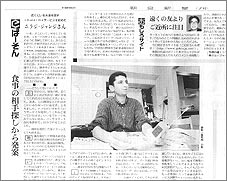ImaHima in Wall Street Journal (August 18, 2000)

Japanese Cell-Phone Service Thrives With ‘Microbilling’
The Wall Street Journal (US)
Staff Reporter of THE WALL STREET JOURNAL
TOKYO — The secret behind the fastest-growing Internet service on the planet — 10 million subscribers in 18 months, with up to 50,000 new users a day — is as commonplace as it is clever: It’s all in the billing.
Called “i-mode,” the Internet-via-cell-phone service is run by Japan’s NTT DoCoMo Inc., the wireless arm of Nippon Telegraph & Telephone Co. Subscribers receive an i-mode phone with which they can send and receive e-mail as well as access Web sites that have been tweaked to fit on tiny screens. With a thumb-controlled joystick, subscribers can tap into online news, browse through restaurant guides, buy plane tickets on Japan Airlines, and trade stocks via DLJ Direct Inc. At the end of the month, any charges imposed by these or other i-mode-approved sites are bundled together in one monthly phone bill — a so-called microbilling system that is simple for users and profitable for the companies involved.
Meet i-mode user Takayo Yamamoto, a 28-year-old worker at a record company in Tokyo. She got her i-mode phone last summer because she wanted to trade e-mail with friends. Now she also uses it to access the Internet to check train schedules, get movie listings and read Japan’s biggest daily newspaper. Some of the services are free; those that aren’t, such as the newspaper, attach their charge to her monthly i-mode bill, where it appears along with a list of other charges from DoCoMo. For Ms. Yamamoto this usually adds up to about 8,000 yen (a bit under $75), which she pays by automatic bank withdrawal.
“The details are all on the bill, so it’s easy to see how much I spent on which services,” says Ms. Yamamoto. “If the bills were sent separately, I wouldn’t use them. It would be too bothersome to pay.”
Though subscribers can use i-mode to access any Web site by tapping out an address, the most popular ones are run by companies that DoCoMo has anointed as official i-mode content suppliers. Those companies’ sites appear in lists on the i-mode screen and can be accessed with the press of a button. While many sites are free, a growing number charge subscription fees, all less than $3 a month.
Half of DoCoMo’s subscribers are paying for an average of two sites each month, says Takeshi Natsuno, one of i-mode’s original developers and now executive director of the i-mode group. “From the subscriber’s side, if the content is good, then 300 yen (less than $3) per month is very cheap,” he says.
For content providers, though, this can translate into big bucks. One of the most popular paid services ships a different animated character each day to cell-phone screens. The service and others run by Bandai Co. now have nearly attracted two million customers, each paying between 100 yen and 300 yen (roughly 92 U.S. cents to $2.75) per month.
Tokyo-based Weathernews Inc. has 170,000 subscribers each paying about $1 each month to read its i-mode weather site, says the company’s chairman, Hiroyoshi Ishibashi. Visits to the company’s i-mode site continually outnumber those to its regular Web site. When a typhoon recently blew through Japan, the i-mode site had about two million hits in a day while the Web site saw 1.6 million hits, Mr. Ishibashi says.
As of this month, DoCoMo had 600 official content providers, and it receives at least five proposals each day from companies seeking i-mode status, Mr. Natsuno says. At the current rate he expects to raise the number of official sites to about 800 within six months.
On the international front, DoCoMo is currently in talks with America Online Inc., the world’s largest Internet-service provider, over jointly developing mobile Internet services in Japan and later in select markets world-wide, according to a person familiar with the talks. Separately, DoCoMo is in talks to acquire a small stake in the wireless phone venture of SBC Communications Inc. and BellSouth Corp., people familiar with the matter said. Mr. Natsuno says that DoCoMo is ready to help cellular providers in other countries introduce mobile Internet services but won’t discuss specifics.
When DoCoMo set out to build i-mode, executives never imagined it would be such a runaway success. The company had blown away rivals in voice service but had zero experience with the Internet. But its design was based on standard Internet technologies so it would be easy for content companies to build i-mode sites.
The i-mode team avoided what it considered vague, and to many Japanese customers off-putting, technical terms such as “Internet” and “Web.”
“The fact that we are using the Internet isn’t necessarily an attractive thing to subscribers,” says DoCoMo’s Mr. Natsuno.
That sort of thinking also drove the design of the billing system. Mr. Natsuno figured he would have to give content providers like newspapers and game companies a way to charge subscriptions that wasn’t a hassle for customers. So the team devised a system that, with the push of a few buttons, i-mode users can choose billable services and have the charge added to their phone bill. DoCoMo takes a 9% cut for those services, plus it charges subscribers a “packet” fee based on the amount of information they send and receive over i-mode.
Although official i-mode sites are reaping the benefits of the billing system, the 19,000 or so independent i-mode sites that have sprung up are on their own in terms of billing customers. Though subscribers can access those sites by typing in their Web addresses, the independents can’t charge fees through DoCoMo.
Some independents complain that DoCoMo has created an exclusive club that runs counter to the “open” nature of the Internet. Many argue that DoCoMo’s packet charges, which average about $16 per subscriber each month, make it expensive for subscribers to spend time on even free i-mode sites.
 Most would love to get in on the billing action. “DoCoMo should … open up billing to other players,” says Neeraj Jhanji, founder of Imahima, a matchmaking service that operates over i-mode but isn’t included in the official sites. “There is no other simpler method for Web-site developers to get their revenues.”
Most would love to get in on the billing action. “DoCoMo should … open up billing to other players,” says Neeraj Jhanji, founder of Imahima, a matchmaking service that operates over i-mode but isn’t included in the official sites. “There is no other simpler method for Web-site developers to get their revenues.”
Mr. Natsuno says letting everyone on the bill is tantamount to giving each DoCoMo’s blessing, which isn’t feasible. DoCoMo has to screen out content that might be illegal or get it in trouble, he says, citing a backlash against NTT years ago when phone-sex companies jumped on to its 1-900 service.
He prefers to compare i-mode’s system to AOL, which offers easy-to-click links to its preferred content providers but also offers a means to tap the broader Internet. He emphasizes that i-mode, in its current form, is just the beginning. “We’re taking a step-by-step approach,” he says.
DoCoMo is also studying other possible payment schemes to complement its microbilling system. Users will probably one day be able to “download” money into their phones to buy things from vending machines or convenience stores. Further down the road are electronic settlement systems that will make phones work like credit or bank debit cards.
But it may well turn out that the microbilling remains at the core of DoCoMo’s system as it evolves in ways that push the Internet itself further into the background. Chikae Arai, 24, doesn’t have a regular phone or personal computer. Each month she racks up about $155 on her i-mode bill, making calls, checking the weather and exchanging e-mail with friends in Japan and Europe.
“There is a link for the Internet,” she says as she uses her thumb to navigate the i-mode menu. “But I don’t have any interest in it.
- Robert A. Guth
ImaHima mentioned in Asahi Newspaper (in Japanese) (June 30, 2000)

 近くにいる友達を探す
近くにいる友達を探す
imaHimaサービスを始めた
ニラジ・ジャンジさん
いま、どこにいて、何をしているかを、iモードのサイトに、伝言板のように登録しておくと、あらかじめ許可した相手が見られるというサービス、「imaHima」(http://www.imahima.com)を運営する。インド出身。友達がどこにいて、ひまかどうかわかるので、一緒に遊んだりするのに便利。NTTドコモには、メニューに表示される公式サイトと、勝手サイトといわれる非公式サイトがあり、これは非公式の1つ。公式サイトの契約社数は約500なのに対して、勝手サイトは1万以上にのぼる。

- どうして思いついた?
去年の2月、昼食の時、近くにいるだれかが一緒に食事してくれたらいいのにと思いました。ああ、この携帯ならだれがどこにいるか知っているはず、と考えました。ドコモがいずれそういうサービスを提供してくれると思っていたけど、いつまでたっても出てこないから、コンサルタント会社を辞めて、自分でやることにした。
- 携帯を利用した電子チラシとしても使える。
地域を限定して情報を流せるからお店の特売を近所にいる人に知らせたり、展示会の案内、レストランの宣伝にも利用できる。去年12月から始めて、もう9万人が加入している。
- 商売としてやっていけるの?
いまは無料だけど、課金しないとやっていけない。でもドコモは公式サイトについては料金の代理徴収をしているのに、勝手サイトのサービスについてはしてくれない。公式サイトになれるように申請したけれど、返事がないし、基準も明確にしてくれない。 商売を始めたばかりで、広告料収入だけではやっていけないから、薄く広く課金するしかない、このままでは勝手サイトの多くはビジネスとして成り立たなくなる。
- 課金だけが大きな問題なの?
iモードの画面1ページ見るのにだいたい3円かかる。うちのサービスを利用すると、平均10ページ見る必要があるから、30円。毎日使うと1ヶ月約1000円になる。うちは9万人の利用者がいるから、毎月データ通信料で1億円近くドコモに払っている計算になる。iモードの基本料は安いけれど、データ通信料金が高いから、ユーザーには負担になる。うちのサービスは無料なのに、やめるユーザーがいるのは、ドコモの料金が高いから。
- 公式サイトに対して不公平だと感じることは?
公式サイトにはどの端末が発信したかを認識する情報を渡しているのに、勝手サイトには出さないという点もおかしい。この情報がないと、同じ端末で複数の契約をして人をだますような不正利用が防げない。そもそも占いやゲームを公式サイトにするより、もっと社会にとって価値のあるサービスが勝手サイトの中にもある。それを公認した方がいいのじゃないかな。
聞き手 原 淳二郎
imaHima on Tonight 2 TV Asahi (part 2) (May 3, 2000)
(in Japanese)
imaHima on Tonight 2 TV Asahi (part 1) (May 3, 2000)
(in Japanese)
